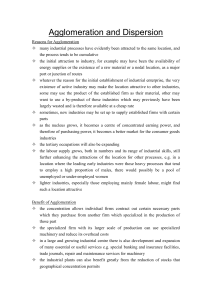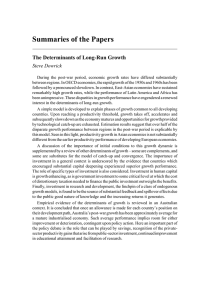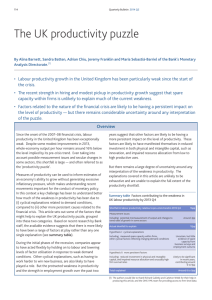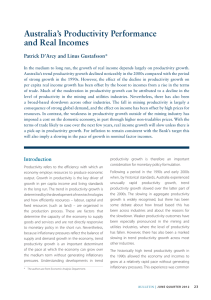The Great Productivity Puzzle
advertisement
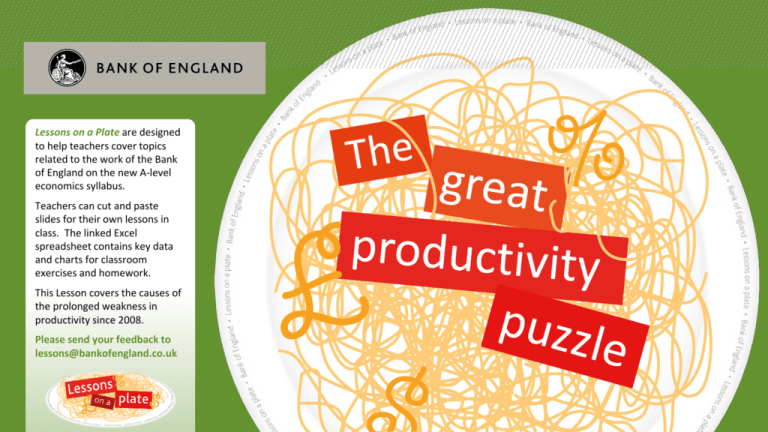
Lessons on a Plate are designed to help teachers cover topics related to the work of the Bank of England on the new A-level economics syllabus. Teachers can cut and paste slides for their own lessons in class. The linked Excel spreadsheet contains key data and charts for classroom exercises and homework. This Lesson covers the causes of the prolonged weakness in productivity since 2008. Please send your feedback to lessons@bankofengland.co.uk Learning Objective: Using this Lesson, students should be able to: Define labour productivity Explain why productivity is an important influence on inflation and monetary policy decisions Explain the main causes of the slowdown in productivity growth CONTENTS Productivity is a measure of the amount of output produced by a unit of labour input It is calculated by dividing output by the number of hours worked. This is called “output per hour”. If productivity rises, it takes fewer hours of work for the economy to produce the same amount of output. That allows firms to increase pay, leading to higher standards of living. Indices, 2011=100 109 Hours worked Output Output per hour 107 105 But Chart 1 shows that output per hour fell across the whole economy (purple line) in 2008 because the number of hours worked (blue line) did not fall as sharply as output (green line) during the financial crisis. 103 101 99 97 95 Question: Output per hour peaked at 102.3 in 2008 (quarter 1) and fell to a low point of 96.2 in 2009 (quarter 1). What was the percentage fall in output per hour between these two dates? Link to dataset 3 CONTENTS Measures of productivity are available for sectors of the economy like services and manufacturing Before the financial crisis, productivity increased rapidly in most parts for the economy. Output per hour, indices, 2011=100 105 Productivity in services increased by over 15% between 2000 and 2008, but grew by less than 1% between 2008 and 2015. 100 95 Like services, manufacturing productivity increased rapidly up to 2008, and slowed thereafter. 90 85 80 Manufacturing Services 75 70 65 Link to dataset 4 CONTENTS Productivity measures are available for each part of the UK Chart 3 compares output per hour in England, Wales, Scotland and Northern Ireland with the whole of the UK(=100). A country above 100 is more productive than the UK, and a country below 100 is less productive. Output per hour, index UK=100, 2013 105 101.7 100 For example, in 2013 Northern Ireland produced 17.8% less output per hour than the UK. 95 96.8 90 85 83.4 82.2 80 75 70 Question: Relative to the UK, how much more output per hour in percentage terms did England produce in 2013? Link to dataset 5 Productivity matters to Bank of England policymakers CONTENTS It’s a key influence on decisions taken by the Bank’s Monetary Policy Committee (MPC) because it governs how fast the economy can grow before it starts to push up inflation. With strong productivity growth, businesses are able to produce more output with fewer hours of work. There is less need to recruit new staff which limits the upward pressure on pay and prices as the economy grows. Without productivity growth, more and more labour is required to produce higher levels of output. Increasing demand for labour pushes up wage costs, putting upward pressure on inflation. Question: If productivity growth is weak while the economy is growing rapidly, would you expect inflation to rise or fall? 6 Economists believe there are four key drivers of increases in productivity CONTENTS Increases in the amount of capital per worker. For example, do workers in a firm have to share a laptop, or does each one have their own? Improvements in the way a business combines its labour and capital. For example, how well has a firm trained its workers to use the machines in its factory? How hard a firm works its labour and capital relative to their full capacity. This is a measure of the amount of spare capacity (or “slack”) in the firm. Less slack means higher productivity. New ideas and new technologies. New inventions like 3D printing can boost worker productivity in ways that weren’t previously possible. Question: (1) Think of a local business where you live. Suggest ways it could increase its productivity. (2) Can you think of an invention that has boosted productivity? 7 CONTENTS The prolonged weakness of productivity since the financial crisis in 2008 is called the “productivity puzzle” Most forecasters – including the Bank of England – have been surprised by the scale and duration of the slowdown in productivity. Index, 2011=100 120 115 Pre-crisis trend in output per hour 110 Before the crisis, the growth of productivity averaged 2.2% per year (see red line in Chart 4). 105 100 Since 2008 productivity has moved broadly sideways (see blue line). In 2015 productivity is around 15% below the level implied by a continuation of its pre-crisis trend (see the dotted black line). Question: The index of productivity in 2015 (quarter 1) is 99.4. Calculate the level of productivity if it were 15% higher. 95 Output per hour (post-crisis) Output per hour (pre-crisis) 90 85 80 Link to dataset 8 CONTENTS Productivity varies around the world Chart 5 compares productivity in the G7 countries. The G7 is a group of the seven largest economies in the world. Output per hour in 2013, index UK=100 Productivity in each country is set here to UK=100. A country above 100 is more productive than the UK and a country below 100 is less productive. 140 127 Chart 5 shows that the United States, for every hour worked, produced 31% more output relative to the UK in 2013. 117 109 The G7 countries as a whole (excluding the UK) were on average 17% more productive than the UK. 130 120 110 101 100 Japan, for every hour worked, produced 15% less output than the UK. 90 85 Question: For every hour worked, how much more output did Germany produce relative to the UK in 2013? 128 131 80 Link to dataset 9 Economists have suggested five main causes of the puzzle CONTENTS Firms hoarded workers: Despite the big fall in output in 2008, businesses held onto workers. This helped firms to avoid the cost of re-hiring staff when the economy picked up. Weaker investment cut the amount of capital per worker: The sharp downturn in 2008 made businesses more cautious about investing in new technologies and skills. And a weaker banking system was less willing to lend money for new investments. Composition of the workforce: Many of the new jobs created during the economic recovery have been in low skilled and low productivity occupations. Capital and labour got stuck in weak businesses with low productivity: Since the financial crisis, banks have been less successful in making loans to the most productive businesses. And official interest rates were cut to a record low of ½% in March 2009. This helped to prop up demand in a weak economy, but it also allowed weak firms with low productivity to continue trading. Official data on output or working hours may be incorrect: If output turns out to be higher, or the number of hours worked weaker, than first estimated by the ONS, this will boost measured productivity. Question: Can productivity in the UK pick up to grow again at pre-crisis levels? 10 Click on the icon to follow the link CONTENTS Data on productivity The latest data on labour productivity from the Office for National Statistics (ONS). “The UK productivity puzzle” An article giving a detailed summary of the Bank’s thinking on causes of the productivity slowdown. “Pay and productivity: the next phase” A speech by Sir Jon Cunliffe on the causes of the slowdown and the outlook for productivity in 2015 and beyond. “Lemons help Pizza Express tackle the productivity puzzle” A BBC News article looking at some of the causes of the puzzle. 11






